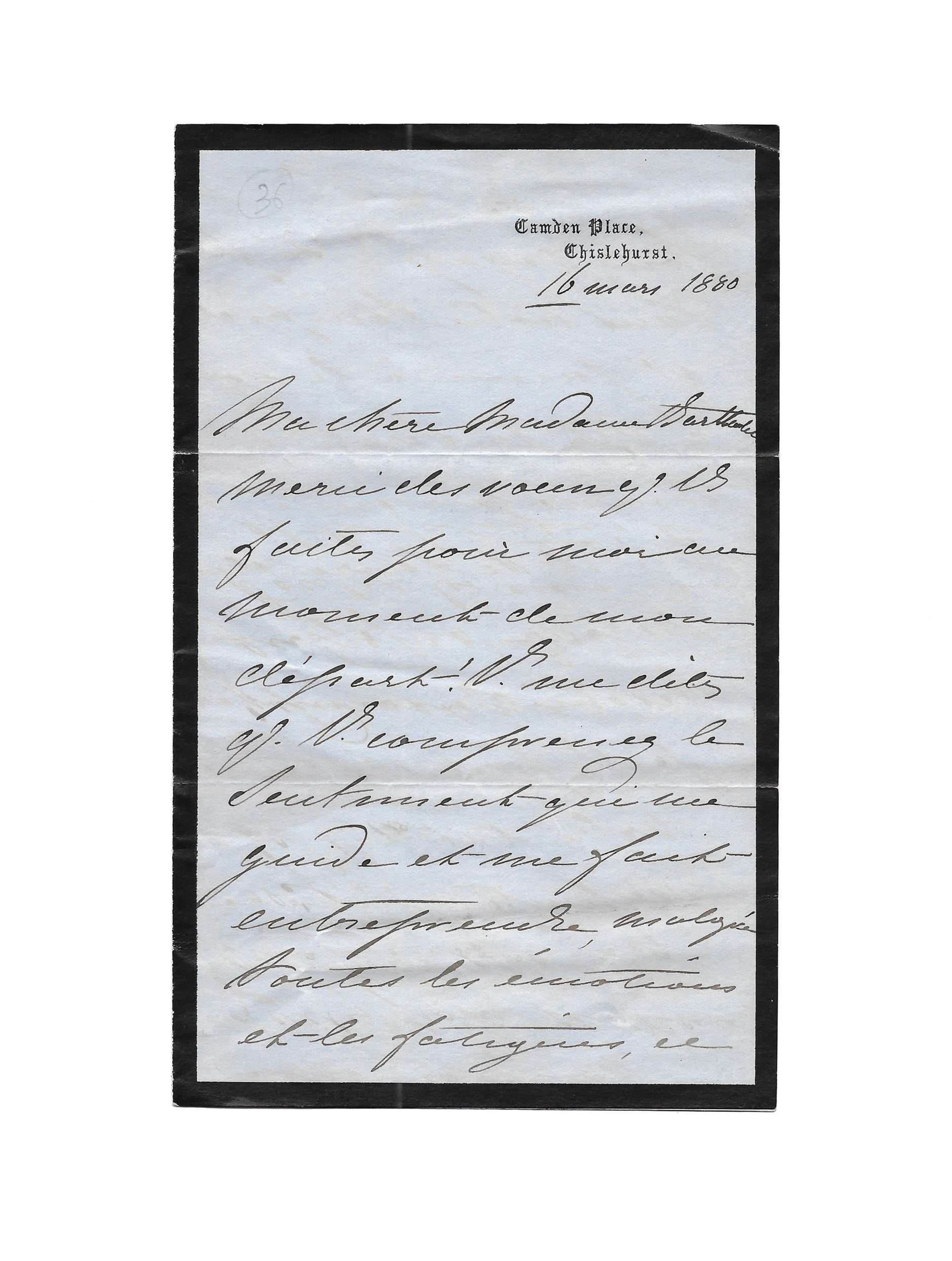MONTIJO (de), Impératrice Eugénie (1826-1920)
Autograph letter signed « Eugénie », to Marie-Thérèse Bartholoni
Camden Place, Chislehurst, 16th March 1880, 4 p. in-8°, mourning paper
« I hope, upon my return, either to be stronger or no longer need to rely on my strengths »
Fact sheet
MONTIJO (de), Impératrice Eugénie (1826-1920)
Autograph letter signed « Eugénie », to Marie-Thérèse Bartholoni
Camden Place, Chislehurst, 16th March 1880, 4 p. in-8°, mourning paper
Very moving letter from the Empress, evoking her imminent departure for Zululand
Written on March 16, the anniversary date of the birth of her son, this letter announces the pilgrimage that the bereaved mother is about to undertake to southern Africa, in the footsteps of the Imperial Prince, who died heroically on June 1, 1879
« Ma chère Madame Bartholoni,
Merci des vœux que vous faites pour moi au moment de mon départ !
Vous me dites que vous comprenez le sentiment qui me guide et me fait entreprendre, malgré toutes les émotions et les fatigues, ce long voyage ! Si peu le comprennent malheureusement dans notre temps de profond égoïsme, que j’aime à le voir approuvé.
On vous a dit la vérité en vous assurant que je ne voyais personne.
Je serais, du reste, hors d’état de faire des adieux. J’espère, à mon retour, ou être plus forte ou n’avoir plus besoin de compter sur mes forces, de sorte que je vous prie de remettre à ce moment-là votre visite. J’espère aussi voir vos enfants quoique vous ne m’en parliez pas.
Vous craignez, et je vous en remercie, de me faire constater la solitude de mon foyer, mais mes propres malheurs ne sauraient changer l’intérêt que je leur porte.
Mes souvenirs à tous les vôtres et croyez à mes sentiments affectueux.
Eugénie »
Imperial Prince Louis-Napoléon Bonaparte (only son of Napoleon III and Empress Eugenie) was a member in England of the Royal Military Academy at Woolwich. In a “Bonapartist” impulse, of which he was the last illustrious descendant, he insisted on his incorporation into the British troops of southern Africa to participate with his comrades in the fight against the Zulus.
Queen Victoria finally authorized him to do so, he embarked in February 1879. On June 1, 1879, he took part in a reconnaissance mission. On horseback with a few men, he arrived at a place called Itelezi, about fifty kilometers west of Dundee. During a stop by a river where they believed they were safe, the patrol was ambushed by Zulu warriors.
Two British soldiers were killed. The troop fled on horseback. The prince tried to run back to his horse. The saddle strap, which was used by his father at the Battle of Sedan and which the prince wanted to use, was out of use and yielded under his weight. He was eventually killed, pierced by seventeen blows of iklwa.
At the end of March 1880, less than a year after the tragic death of her son, Eugénie decided to undertake, against the unanimous advice of her entourage, a pilgrimage to South Africa to meditate on the exact place where her son had lost his life. She undertook this journey incognito under her usual name of “Countess of Pierrefonds”.
Goddaughter of Chateaubriand and lady-in-waiting at the Tuileries of Princess Julie Bonaparte, Madame Bartholoni (1833-1910) was, by her beauty, one of the ornaments of the Court of the Second Empire. Born Marie-Thérèse Frisell (1833-1910), she was the wife of Anatole Bartholoni (1822-1902).
Madame Bartholoni held a brilliant salon, which inspired Marcel Proust. The writer actively frequented it in the years 1897-1899. Proust courted, for a time, one of Madame Bartholoni’s three daughters, Louise known as “Kiki” (1857-1933), goddaughter of Empress Eugenie.
